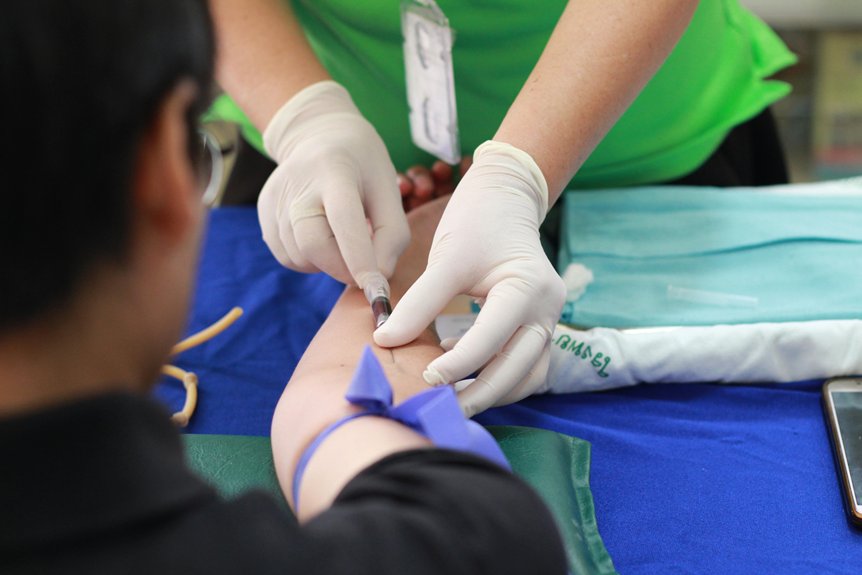The U.S. Surgeon General’s declaration of gun violence as a public health crisis introduces a crucial shift in how we approach this issue. It prioritizes research funding and policy development, aiming to uncover root causes and implement effective interventions. This declaration also promotes collaboration among health sectors and community organizations. As you consider these implications, think about how this new framework could transform strategies aimed at reducing gun violence in your community.
Key Takeaways
- Increased funding for gun violence research will support the identification of root causes and effective prevention strategies.
- A public health framework promotes collaborative efforts among health professionals, policymakers, and community organizations to address gun violence.
- Enhanced community outreach programs empower residents and foster resilience through targeted prevention initiatives tailored to local needs.
- Strengthened data collection improves understanding of gun violence trends and facilitates collaboration between public health and law enforcement agencies.
- Focus on vulnerable populations highlights health disparities and drives equitable access to support services and resources.
Increased Funding for Gun Violence Research
As gun violence continues to escalate, it’s essential that we prioritize increased funding for research to understand its root causes and effective prevention strategies.
Current gun violence statistics reveal alarming trends, highlighting the urgent need for thorough data collection and analysis. By investing in public health funding, you can support studies that explore socio-economic factors, mental health issues, and community interventions.
This research can inform evidence-based policies aimed at reducing gun-related injuries and deaths. Without adequate funding, efforts to combat this crisis remain fragmented and ineffective, limiting our ability to implement impactful solutions that can save lives.
Shift in Public Health Policy Framework
As you examine the shift in public health policy regarding gun violence, you’ll notice a significant push for enhanced research funding that directly informs prevention strategies.
By fostering collaborative efforts between health professionals, policymakers, and community organizations, effective interventions can be developed and implemented.
This strategic alignment not only addresses the immediate impacts of gun violence but also promotes long-term solutions rooted in data-driven insights.
Enhanced Research Funding
While public awareness of gun violence as a pressing public health crisis has increased, the need for enhanced research funding remains critical to address its complex causes and consequences.
Investing in research enables you to understand the intricate relationship between gun violence and community resilience. By funding studies focused on preventive healthcare, policymakers can identify effective interventions that mitigate risks and enhance safety in vulnerable populations.
This funding not only supports the development of evidence-based strategies but also fosters collaboration among researchers, healthcare providers, and communities, ultimately leading to a more robust public health response to this urgent issue.
Collaborative Prevention Strategies
Increased research funding lays the groundwork for innovative collaborative prevention strategies that reflect a shift in public health policy.
By fostering community partnerships, you can leverage local insights and resources to address gun violence effectively. Implementing violence interruption programs, which engage trusted community members to mediate conflicts before they escalate, can greatly reduce incidents.
These strategies not only enhance safety but also promote social cohesion. Data-driven approaches, combined with community input, guarantee that interventions are tailored to specific needs, maximizing their impact.
Ultimately, embracing this collaborative framework positions public health as a key player in combating gun violence.
Enhanced Community Outreach Programs
To effectively tackle gun violence, targeted prevention initiatives are essential for addressing specific community needs.
By fostering collaborative community engagement, you can create a supportive environment that encourages participation and empowers residents.
These outreach programs must be data-driven, ensuring that resources are allocated where they can have the most impact.
Targeted Prevention Initiatives
As communities grapple with the pervasive issue of gun violence, implementing targeted prevention initiatives through enhanced outreach programs becomes essential.
You should prioritize targeted outreach efforts that engage at-risk populations, fostering relationships and trust. By integrating prevention education into these initiatives, you can empower individuals with knowledge about conflict resolution and the consequences of gun violence.
Evidence shows that community-based programs effectively reduce incidents when they tailor their approaches to specific demographics. Investing in these targeted initiatives not only addresses immediate concerns but also lays the groundwork for long-term cultural change, ultimately contributing to safer environments for everyone.
Collaborative Community Engagement
While fostering a sense of community can seem challenging, collaborative engagement through enhanced outreach programs is essential for addressing gun violence effectively.
By leveraging community partnerships and grassroots initiatives, you can create a unified front against this crisis. Research shows that when local organizations work together, they can better identify and address the unique factors contributing to violence in their neighborhoods.
Implementing tailored programs that involve residents fosters trust and encourages participation. By prioritizing community voices and mobilizing resources, you’ll not only enhance the effectiveness of interventions but also cultivate a safer environment for everyone, ultimately reducing gun violence in your area.
Strengthened Data Collection and Analysis
Strengthened data collection and analysis are essential for effectively addressing gun violence as a public health crisis. By enhancing data transparency, you enable better tracking of gun violence trends and outcomes.
Employing robust statistical methodologies allows for accurate assessments of risk factors, helping to identify vulnerable populations. This evidence-based approach lays the groundwork for targeted interventions and informs policy decisions.
Robust statistical methodologies enable precise risk factor assessments, paving the way for targeted interventions and informed policy decisions.
Additionally, improving data systems can facilitate collaboration among researchers, policymakers, and community organizations, ensuring that resources are allocated efficiently.
Ultimately, thorough data collection empowers communities to implement preventive measures and mitigate the impact of gun violence on public health.
Greater Collaboration Between Public Health and Law Enforcement
Improving data collection not only enhances understanding of gun violence but also sets the stage for greater collaboration between public health and law enforcement.
By fostering interagency partnerships, agencies can leverage each other’s strengths to develop thorough strategies. Effective information sharing is essential; it allows for real-time data exchange about incidents and trends, improving responses and preventative measures.
Collaborative efforts can lead to targeted interventions, reducing the prevalence of gun violence. Additionally, these partnerships can facilitate community engagement initiatives, addressing root causes and promoting safety.
Ultimately, a unified approach can transform the landscape of public health and law enforcement.
Expansion of Mental Health Services
As communities grapple with the pervasive issue of gun violence, expanding mental health services emerges as a critical strategy for addressing underlying factors that contribute to this crisis. By enhancing mental health awareness and implementing effective crisis intervention programs, you can foster resilience and support for at-risk individuals.
| Mental Health Service | Key Benefits | Policy Implications |
|---|---|---|
| Community Counseling | Reduces stigma, fosters connection | Funding for local clinics |
| Crisis Hotlines | Immediate support available | Training for responders |
| School Programs | Early intervention | Integration in curricula |
| Support Groups | Builds community support | Grants for facilitators |
Development of Evidence-Based Prevention Strategies
To effectively address gun violence, you need to focus on the development of evidence-based prevention strategies that prioritize research funding allocation, community-based programs, and policy development initiatives.
Allocating resources toward thorough studies can identify what truly works in reducing violence.
Implementing targeted community programs and robust policies can create sustainable change, ultimately improving public health outcomes.
Research Funding Allocation
While many public health issues receive substantial research funding, gun violence remains underfunded, hindering the development of effective, evidence-based prevention strategies.
You might consider how shifting research priorities can attract diverse funding sources, ultimately enhancing our understanding of gun violence. Advocating for increased investment in targeted studies can lead to innovative solutions and better-informed policies.
Engaging public health entities, private foundations, and governmental organizations to prioritize this crisis will foster a robust research landscape. By aligning funding with pressing needs in gun violence prevention, you can help guarantee that strategies are based on solid evidence, ultimately saving lives.
Community-Based Programs
Community-based programs play an essential role in developing evidence-based prevention strategies for gun violence, particularly when tailored to the specific needs of local populations.
These initiatives enhance community resilience by fostering collaboration among residents, local organizations, and law enforcement. By focusing on data-driven approaches, you can identify the root causes of violence and implement targeted interventions.
Successful programs often include conflict resolution training, youth engagement activities, and mental health support, all of which contribute to violence prevention.
Ultimately, investing in community-based programs not only addresses immediate concerns but also builds a foundation for long-term safety and well-being in your community.
Policy Development Initiatives
Effective policy development initiatives are essential for creating evidence-based prevention strategies that address gun violence as a public health crisis. You need to focus on robust policy frameworks that encourage public engagement and collaboration among stakeholders. By leveraging data and research, these initiatives can design targeted interventions that resonate with communities.
| Policy Frameworks | Public Engagement |
|---|---|
| Evidence-based strategies | Community workshops |
| Data-driven decision-making | Stakeholder partnerships |
| Multi-sector collaborations | Public awareness campaigns |
Heightened Public Awareness Campaigns
As gun violence increasingly emerges as a public health crisis, heightened public awareness campaigns play a critical role in shaping perceptions and driving policy change.
These campaigns foster community awareness and support educational initiatives that inform the public about the realities of gun violence.
Here are three key elements of effective campaigns:
- Targeted Messaging: Tailored communication strategies address specific community needs and concerns.
- Partnerships: Collaborating with organizations amplifies reach and resources for impactful outreach.
- Data-Driven Approaches: Utilizing evidence and statistics enhances credibility and informs policy advocacy.
Together, these strategies can mobilize communities toward meaningful action against gun violence.
Focus on Vulnerable Populations
While addressing gun violence as a public health crisis, it’s essential to focus on vulnerable populations that bear the brunt of its impacts.
Vulnerable demographics, including low-income communities and racial minorities, experience significant health disparities due to gun violence. These groups face higher rates of exposure to violence, leading to increased mental health issues and limited access to healthcare resources.
Policy interventions should prioritize these populations, ensuring equitable access to support services and preventive measures.
Long-Term Health Implications of Gun Violence
Gun violence doesn’t just have immediate consequences; it also leaves lasting scars on physical and mental health that can persist for years.
Gun violence inflicts enduring physical and mental health scars that can last for years.
You might experience:
- Long-term disability: Survivors often face chronic pain or mobility issues, affecting daily activities and employment.
- Psychological trauma: Exposure to violence can lead to PTSD, anxiety, and depression, impacting relationships and quality of life.
- Increased healthcare costs: Ongoing treatment for physical and mental health issues can strain personal and public health resources.
Addressing these implications requires extensive policies that prioritize prevention, recovery, and support for affected individuals and communities.
Conclusion
The U.S. Surgeon General’s declaration of gun violence as a public health crisis marks a pivotal shift in addressing this urgent issue. By prioritizing research funding, enhancing community outreach, and fostering collaboration among various stakeholders, you can expect significant advancements in prevention strategies. This approach not only raises awareness about the disparities faced by vulnerable populations but also lays the groundwork for thorough policies aimed at reducing gun violence and promoting long-term community safety and health.




